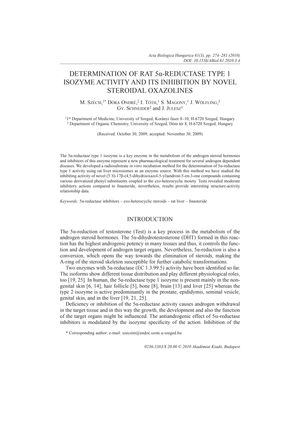Determination of rat 5α-reductase type 1 isozyme activity and its inhibition by novel steroidal oxazolines
September 2010
in “Acta Biologica Hungarica”

TLDR New steroidal compounds moderately block an enzyme related to testosterone conversion, less effectively than finasteride.
In the 2010 study, researchers developed an in vitro method to measure the activity of the 5α-reductase type 1 isozyme using rat liver microsomes and tested the inhibitory effects of novel steroidal oxazolines on this enzyme. These compounds, with derivatized phenyl substituents, showed moderate inhibitory activity compared to finasteride, with the most potent novel inhibitor having an IC50 value of 0.72 µM versus finasteride's 0.0080 µM. The study found that a 2-chlorophenyl substituent increased inhibitory potential, while fluorine decreased it, suggesting these steroidal compounds could be further researched as potential 5α-reductase type 1 inhibitors. The research was supported by the Hungarian Scientific Research Fund and acknowledged contributions from Dr. Zoltán Tuba and Mihály Szécsi.
View this study on publicatio.bibl.u-szeged.hu →
Cited in this study
research 5α‐Reductase Isozymes and Androgen Actions in the Prostate
Androgens, particularly testosterone and dihydrotestosterone (DHT), played crucial roles in prostate development and pathology, with DHT being converted from testosterone by 5α‐reductase isozymes. Two isozymes were identified, with 5α‐reductase‐2 being predominant in the human prostate. Mutations in the 5α‐reductase‐2 gene caused a deficiency syndrome, leading to a small, rudimentary prostate in affected individuals, who did not develop benign prostate hyperplasia (BPH) or prostate cancer. Animal studies with 5α‐reductase‐2 gene knockout or specific inhibitors also showed reduced prostate size. These isozymes were key targets for preventing and treating BPH and prostate cancer, and androgen actions on prostate gene expression and growth were modulated by estrogen receptor ligands. The research underscored the significance of 5α‐reductase isozymes in male sexual differentiation and prostate health.
research Selective non-steroidal inhibitors of 5α-reductase type 1
The enzyme 5 alpha-reductase (5 alpha R) catalyzed the conversion of testosterone into dihydrotestosterone (DHT), which was linked to conditions like benign prostatic hyperplasia, prostate cancer, acne, androgenetic alopecia in men, and hirsutism in women. Two isozymes, 5 alpha R-1 and 5 alpha R-2, were identified, each with distinct characteristics and tissue distributions, suggesting different roles in disease pathogenesis. The development of selective inhibitors for these isozymes, particularly non-steroidal inhibitors targeting 5 alpha R-1, was a significant focus in pharmaceutical research to create more specific treatments for DHT-related disorders. The paper reviewed major classes of these inhibitors and discussed biological tests for their efficacy.

research Testosterone Metabolism in Human Skin Cells in vitro and Its Interaction with Estradiol and Dutasteride
Different skin cells process testosterone differently, and certain drugs can change this process, possibly helping treat acne and hair loss.

research Cutaneous Androgen Metabolism: Basic Research and Clinical Perspectives
Creating stronger blockers for skin enzymes might lead to better treatment for conditions like acne and excessive hair growth.

research Novel inhibitors of 5α-reductase
New research is needed to create better drugs that block the enzyme responsible for conditions like male baldness and prostate enlargement.

research 5α-reductase activity in the prostate
Blocking the enzyme 5α-reductase can shrink the prostate and help treat enlarged prostate issues.
Related
research Role of 5α-reductase inhibitors in benign prostatic diseases

research Finasteride
Finasteride treats enlarged prostate and may help with baldness, but effects on sexual function and male fetuses are unclear.